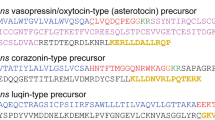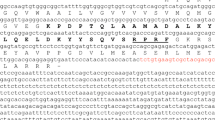Abstract
The VD1 and RPD2 neurons of Lymnaea stagnalis innervate other central neurons, certain skin areas, the pneumostome area, and the auricle of the heart. Recently, a set of four (λ, ω, α, β) neuropeptides produced by these giant neurons and by certain other central neurons has been characterized. Although alternative splicing of the preprohormone of these neurons yields at least 10 different α neuropeptides, an affinity-purified antiserum directed against a domain common to all α neuropeptides has previously been shown to be highly selective in staining VD1, RPD2 and other neurons that produce the preprohormone. Since the gene encoding the neuropeptides is structurally similar to that expressed in R15 of the marine opisthobranch Aplysia californica, we have used the affinity purified antiserum as a marker for VD1/RPD2-related systems in other molluscs. Immunopositive neurons and fibers are observed in the central nervous systems of all species studied (Achatina fulica, Anodonta sp., Aplysia brasiliana, A. californica, Bulinus truncatus, Cepea sp., Eobania vermiculata, Helix aspersa, H. pomatia, Limax maximus, Mytilus edulis, Nassarius reticulatus, Viviparus viviparus). Several medium-sized and small neurons and 1–4 giant neurons are found in the pulmonates and opisthobranchs. The giant neurons in pulmonates have locations in the subesophageal ganglion, axonal branching patterns, and terminal arborizations in the auricle of the heart; all these characteristics are similar to those of VD1 and RPD2. Double-labelling (Lucifer yellow injection, immunocytochemistry) confirms that the two giant neurons in Helix pomatia are Br and Br. The immunoreactive cells in A. fulica appear to include the VIN and PON neurons. The antiserum also stains cells that appear to be the R15 neurons in two Aplysia species. The small and medium-sized neurons are distributed widely over the central ganglia of opisthobranchs and pulmonates. In prosobranchs and bivalves, small neurons are found in the cerebral and abdominal ganglia. No evidence has been found for innervation of the heart in these latter groups but in M. edulis, immunoreactive terminals can be observed in the gill. The results suggest the evolutionary conservation of immunoreactive peptides and the neurons that produce them, and thus support and extend previous hypotheses regarding the homology of certain giant neurons across molluscan species.
Similar content being viewed by others
References
Alevizos A, Weiss KR, Koester J (1991) Synaptic actions of identified peptidergic neuron R15 in Aplysia. I. Activation of respiratory pumping. J Neurosci 11:1263–1274
Andrews EB, Little C (1972) Ultrafiltration in the gastropod heart. Nature 234:411–412
Arshavsky YI, Deliagina TG, Gelfand IM, Orlovski GN, Panchin YV, Pavlova GA, Popova LB (1990) Neural control of heart beat in the pteropodial mollusc Clione limacina: coordination, circulatory and locomotor system. J Exp Biol 148:461–475
Boer HH, Algera NA, Lommerse AW (1973) Ultrastructure of possible sites of ultrafiltration in some gastropoda with particular reference to the auricle of the freshwater prosobranch Viviparus viviparus. Z Zellforsch 143:329–341
Bogerd J (1992) Generation of neuropeptide diversity by alternative splicing in two giant neurons, VD1 and RPD2, of the mollusc Lymnaea stagnalis. Thesis, Vrije Universiteit, Febodruk BV, Enschede, The Netherlands
Bogerd J, Geraerts WPM, Heerikhuizen H, Kerkhoven RM, Joosse J (1991) Characterization and evolutionary aspects of a transcript encoding a neuropeptide precursor from Lymnaea neurons VD1 and RPD2. Mol Brain Res 11:47–54
Bogerd J, Van Kesteren RE, Veenstra J, Van Heerikhuizen H, Geraerts WPM, Smit AB, Joosse J (1993) Alternative splicing generates neuropeptide diversity in the central nervous system of Lymnaea stagnalis. Cell Mol Neurobiol (in press)
Buck LJ, Bigelow JM, Axel R (1987) Alternative splicing in individual Aplysia neurons generates neuropeptide diversity. Cell 51:127–133
Chase R, Goodman HE (1977) Homologous neurosecretory cell groups in the land snail Achatina fulica and the sea slug Aplysia californica. Cell Tissue Res 176:109–120
De With ND (1980) Water turn-over, ultrafiltration, renal water reabsorption and renal circulation in fed and starved specimens of Lymnaea stagnlais, adapted to different external osmolarities. Proc K Ned Acad Wet 83:109–120
Furakawa Y, Kobayashi M (1987) Neural control of heart beat in the African giant snail, Achatina fulica Frussac. I. Identification of the heart regulatory neurones. J Exp Biol 129:279–293
Gainer H (1972) Electrophysiological behaviour of an endogenously active neurosecretory cell. Brain Res 39:403–417
Goto T, Ku BS, Takeuchi H (1986) Axonal pathways of giant neurons identified in the right parietal and visceral ganglia in the suboesophageal ganglia of the African giant snail (Achatina fulica Ferussac). Comp Biochem Physiol [A] 83:93–104
Ifshin MS, Gainer H, Barker JL (1975) Peptide factor extracted from molluscan ganglia that modulates bursting pacemaker activity. Nature 254:72–74
Kerkhoven RM, Van Minnen J, Boer HH (1990) Neuron specific monoclonal antibodies raised against the low molecular weight fraction of a brain homogenate of the pond snail Lymnaea stagnalis immuno-react with neurons in the central nervous system of the cockroach, the guppy, the wall lizard, the rat and man. J Chem Neuroanat 3:337–346
Kerkhoven RM, Croll RP, Van Minnen J, Bogerd J, Ramkema MD, Lodder H, Boer HH (1991) Axonal mapping of giant peptidergic neurons VD1 and RPD2 located in the CNS of the pond snail Lymnaea stagnalis with particular reference to the innervation of the heart. Brain Res 565:8–16
Kerkhoven RM, Croll RP, Ramkema MD, Bogerd J, Van Minnen J, Boer HH (1992) Morphology of the VD1/RPD2 neuronal system in the CNS of the pond snail Lymnaea stagnalis studied by in situ hybridization and immunocytochemistry. Cell Tissue Res 267:551–559
Kerkut GA, Lambert JDC, Gayton RJ, Loker JE, Walker RJ (1975) Mapping of nerve cells in the suboesophageal ganglia of Helix aspersa. Comp Biochem Physiol [A] 50:1–25
Kupfermann I, Weiss KR (1976) Water regulation by a presumptive hormone contained in identified neurosecretory cell R15 of Aplysia. J Gen Physiol 67:113–123
Moore RC, Pitrat CW (1960) Treatise on invertebrate paleontology. Part 2, Mollusca 1. Geological Society of America and University of Kansas Press, Kansas City
Pin T, Gola M (1983) Two identified interneurons modulate the firing pattern of pacemaker bursting cells in Helix. Neurosci Lett 37:117–122
Pin T, Gola M (1984a) Axonal mapping of neurosecretory Helix bursting cells. Comp Biochem Physiol [A] 78:637–649
Pin T, Gola M (1984b) Axonal mapping of neurosecretory Helix bursting cells. Functional aspects of peripheral multibranched axons. Comp Biochem Physiol [A] 79:611–620
Sakharov DA (1976) Nerve cell homologies in gastropods. In: Salanki J (ed) Neurobiology of invertebrates. Publishing House of the Hungarian Academy of Sciences, Tihany, pp 27–39
Skelton ME, Koester J (1991) Innervation of the heart of Aplysia by serotonin- and R15α2 peptide-immunoreactive terminals, and by L2. Soc Neurosci Abstr 17:1355
Soffe SR, Benjamin PR (1980) Morphology of two electrotonicallycoupled giant neurosecretory neurons in the snail Lymnaea stagnalis. Comp Biochem Physiol [A] 67:35–46
Sternberger LA (1986) Immunocytochemistry, 3rd edn. Wiley, New York
Van der Wilt GJ, Roest M, Janse C (1987) Neuronal substrates of respiratory behavior and related functions in Lymnaea stagnalis. In: Boer HH, Gerearts WPM, Joosse J (eds) Neurobiology, molluscan models. Proceedings of the Second Symposium on Molluscan Neurobiology. North Holland, Amsterdam, pp 292–296
Author information
Authors and Affiliations
Rights and permissions
About this article
Cite this article
Kerkhoven, R.M., Ramkema, M.D., Van Minnen, J. et al. Neurons in a variety of molluscs react to antibodies raised against the VD1/RPD2 α-neuropeptide of the pond snail Lymnaea stagnalis . Cell Tissue Res 273, 371–379 (1993). https://doi.org/10.1007/BF00312840
Received:
Accepted:
Issue Date:
DOI: https://doi.org/10.1007/BF00312840




